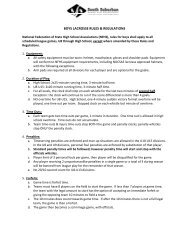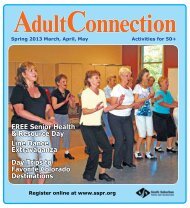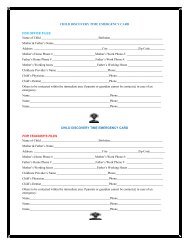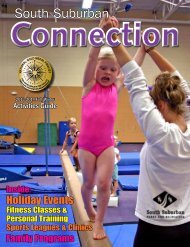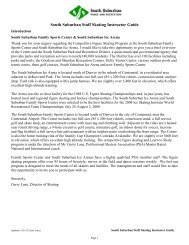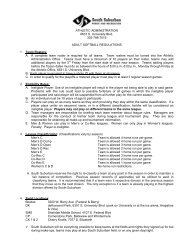2012 Budget - South Suburban Parks and Recreation
2012 Budget - South Suburban Parks and Recreation
2012 Budget - South Suburban Parks and Recreation
Create successful ePaper yourself
Turn your PDF publications into a flip-book with our unique Google optimized e-Paper software.
<strong>South</strong> <strong>Suburban</strong> Park <strong>and</strong> <strong>Recreation</strong> District<br />
Capital Improvement Plan<br />
Project Highlights for <strong>2012</strong> (continued)<br />
3. Central Irrigation Control replacements ($48,000) - When the first controllers for the<br />
central control systems were installed in 1991, they were st<strong>and</strong> alone F-Units. These<br />
controllers had direct communication to the base station <strong>and</strong> at the time functioned<br />
quite well. Over the past 20 years these, due to the advancements, these controllers<br />
have become outdated <strong>and</strong> obsolete. We can no longer purchase parts or replacement<br />
components. The cost for repairs averages around $200.00 per unit. There were 32<br />
repairs over the last 16 months. In <strong>2012</strong> we would like to upgrade the controllers at<br />
Lewis Ames, Sunset, LaQuinta, Palos Verdes West, Ida, Barnes, Sheridan Middle<br />
School, <strong>and</strong> Harlow Pool.<br />
4. Tennis Court Repairs $17,500 - District staff evaluates the condition of all the<br />
outdoor tennis courts annually. The information collected during these inspections as<br />
well as the scheduled use of each court helps us to establish the priorities for needed<br />
repairs. Generally the primary objective is to patch the cracks on all the courts <strong>and</strong> in<br />
some cases re-coloring <strong>and</strong> stripping if the courts condition warrants. Patching the<br />
cracks prevents moisture from getting under the courts which can cause additional<br />
damage. This process also helps to minimize further cracking.<br />
Operating Impact of Capital Projects<br />
In addition to the cost of the capital project, the impact on operating costs is important when<br />
recommending a project for funding. The District defines Routine Capital Projects (or called<br />
Replacement) as replacement equipment <strong>and</strong> facility <strong>and</strong> park improvements. Non-routine<br />
Capital Projects (or called New) are defined as projects that are infrequent, new, or have a<br />
significant improvement which exp<strong>and</strong>s the original usage. Non-routine projects can also<br />
include projects with grant <strong>and</strong> joint funding sources.<br />
For <strong>2012</strong>, $4,804,614 ($7,033,182 less undesignated $2,228,368) is budgeted for Routine<br />
capital projects. A majority of these projects include improvements to existing parks, trails,<br />
<strong>and</strong> facilities or replacement of old equipment, vehicles, <strong>and</strong> computers. These projects will<br />
have a minimal impact on current operating expenditures <strong>and</strong> are likely to lead to a reduction<br />
in long term operating expenditures. Replacement of older equipment, vehicles, etc with<br />
more efficient items will have the greatest impact on the operating budget. Some of these<br />
projects include replacement mowers, vehicles, golf equipment, lighting, <strong>and</strong> newer<br />
computers. Replacement of older items <strong>and</strong> improvements to facilities decrease the<br />
maintenance costs <strong>and</strong> prolongs the life of existing assets.<br />
75



